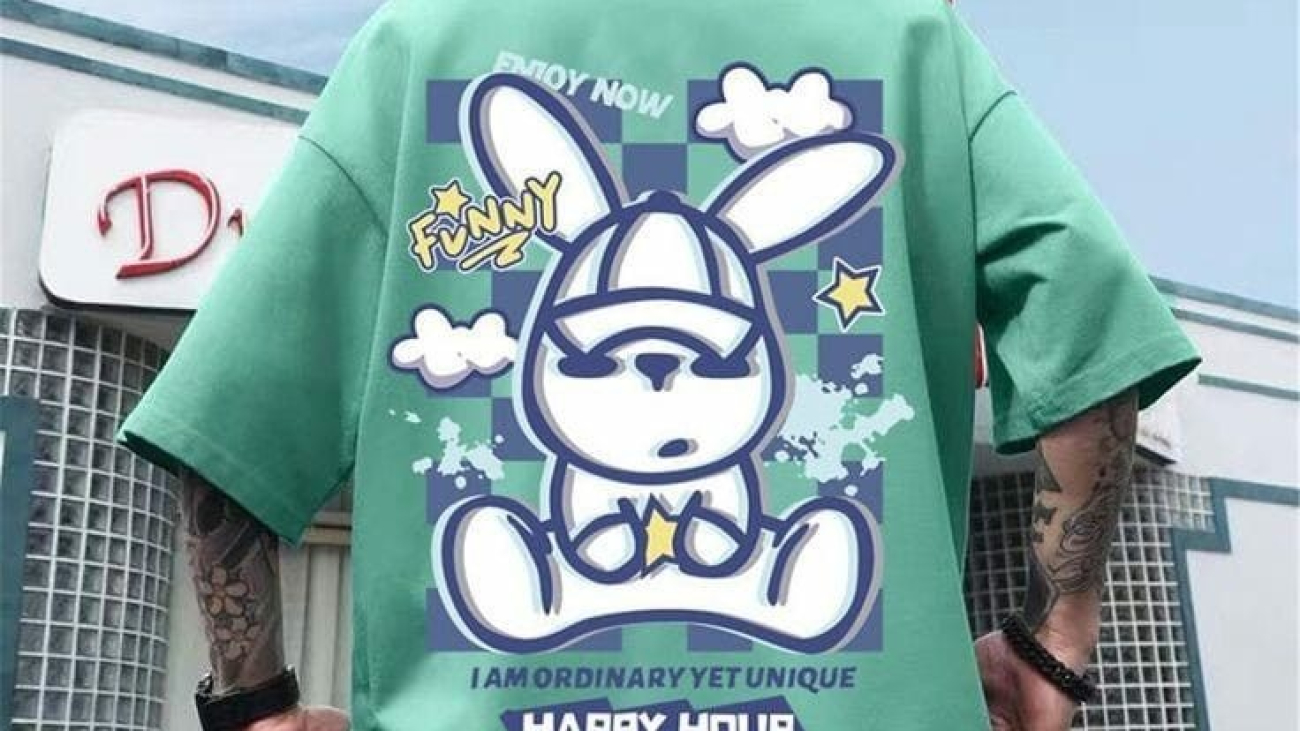Thought for 5 seconds
T-shirts are perhaps the most ubiquitous garment in modern wardrobes, crossing barriers of age, gender, culture, and occasion. Their humble origins lie in functional undergarments of a bygone era, yet they have evolved into canvases for self-expression and style statements. From the simplest crew neck styles to intricate graphic prints, the versatility of the T-shirt is unparalleled. It offers comfort, ease of care, and an effortless way to convey personal taste. Whether worn alone on warm days or layered beneath jackets and sweaters, it remains a staple in casual and even semi-formal dress codes around the globe.
The story of the T-shirt begins with a garment designed for practicality. Early laborers and sportsmen required a lightweight piece that allowed for freedom of movement and breathability. This practical need sparked innovation in textile production, leading to the adoption of knit fabrics that provided stretch and softness. Over time, what began as an underlayer moved into public view, especially as social norms around casual dress relaxed. Actors, musicians, and everyday people alike discovered the appeal of a simple shirt that spoke volumes without saying much at all.
Fabric selection lies at the heart of what makes a T-shirt desirable. Cotton, in its various weaves and treatments, remains a favorite for its natural feel and moisture-absorbing qualities. Organic variations appeal to environmentally conscious consumers, offering the same advantages while minimizing chemical use. Blends with synthetic fibers add durability and stretch, enhancing shape retention and reducing the tendency to wrinkle or shrink. Advances in textile technology have introduced moisture-wicking performance fabrics originally developed for athletics, now widely adopted in everyday wear. Each choice of material brings its own set of benefits, catering to diverse needs and preferences.
Styling a T-shirt can be as simple or as adventurous as one desires. A plain shirt in a neutral tone pairs seamlessly with denim or chinos, creating an effortlessly polished look. Add a tailored blazer or a structured coat, and the casual piece gains an element of sophistication. For more daring ensembles, bold graphic prints and bright colors inject personality and draw attention. Layering opens yet more possibilities: drape a T-shirt under a slip dress for a fusion of edgy and feminine, or let it peek out beneath an open-weave sweater for textural contrast. The universal shape of the shirt allows it to harmonize with nearly every silhouette.
Graphic T-shirts stand as powerful vessels for communication. Musicians imprint album artwork and tour dates across chests and backs, forging a tangible connection between artist and fan. Design studios collaborate with painters and illustrators to transform blank fabric into wearable art. A witty slogan or a striking image conveys beliefs, affiliations, or sense of humor. For creators, this medium offers an accessible route to share messages without speaking a word. In turn, wearers curate their personal narrative, broadcasting pieces of identity to passersby. In many ways, the printed T-shirt has become a modern billboard for individual voice.
Cut and construction influence both comfort and fit. Classic crew necks offer a timeless round opening at the collar, flattering various body types. V-necks introduce a subtle elongation of the neck, adding a touch of refinement. Sleeveless versions grant freedom of movement for sporting activities, while raglan sleeves extend the shoulder line for a sportier aesthetic. Hem variations, such as curved or split sides, modernize the silhouette and allow for flexible styling. High-low hems, where the back sits slightly longer than the front, accommodate tucking and layering. These design nuances elevate the simplest garment into a considered piece of fashion.
Sustainability concerns have reshaped the industry’s approach to T-shirt production. Fast fashion’s relentless churn of inexpensive items has strained ecosystems and labor communities. In response, brands now emphasize transparent supply chains, ethical labor practices, and recycling initiatives. Some companies upcycle textile waste into new fabrics, while others offer take-back programs that repurpose worn shirts into insulation or cleaning cloths. Consumers increasingly seek certifications that guarantee reduced water usage and fair wages. As environmental awareness grows, the humble T-shirt becomes a battleground for positive change in manufacturing and consumption patterns.
Personalization services further enrich the T-shirt experience. Custom printing platforms invite individuals to upload photographs or text, creating one-of-a-kind pieces for special occasions or merchandise needs. Group orders for events such as family reunions, sports teams, or corporate gatherings foster camaraderie through matching attire. Advances in direct-to-garment printing allow for photographic detail in full color, previously achievable only through more labor-intensive screen printing. This democratization of design means anyone can transform a blank canvas into a meaningful keepsake or promotional tool without minimum order requirements.
Caring for T-shirts ensures longevity and keeps the fabric looking its best. Gentle washing in cool water preserves color vibrancy, while air drying prevents undue stress on fibers. When ironing is needed, a low-heat setting alongside a pressing cloth avoids scorching prints and logos. Storing shirts folded rather than hung reduces stretching at the shoulders, preserving shape over time. Spot treatments for stains should be applied promptly, with natural solutions like mild detergent or baking soda favored over harsh chemicals. Through mindful maintenance, a favorite T-shirt can remain a wardrobe mainstay for years.
Cultural impact of the T-shirt extends beyond fashion. It has become a symbol of rebellion and unity alike. Political activists don shirts emblazoned with slogans to galvanize support and raise awareness. Nonprofit organizations distribute shirts at fundraising events, transforming donors into walking advocates. In film and literature, a character’s choice of T-shirt can signal allegiance to a movement or subculture. Slowly, this garment has woven itself into the cultural fabric, carrying meaning that transcends its physical form. When worn with intent, it communicates solidarity or dissent with remarkable clarity.
Economics of T-shirt production reveals a complex global ecosystem. Cotton cultivation in one region connects to spinning and weaving in another, while printing and assembly may occur elsewhere entirely. Market demand for low-cost basics drives manufacturers to seek efficiencies, sometimes at the expense of labor rights. Yet consumer pressure has begun to shift practices, encouraging fair trade labels and local manufacturing. Small-batch producers experiment with artisanal techniques, offering premium alternatives to standardized mass-market options. Even at entry-level price points, shoppers grow more mindful of the environmental and social footprint embedded in every stitch.
Innovation in T-shirt design continues to push boundaries. Smart textiles embed sensors that monitor biometric data or adjust temperature in response to body heat. Antimicrobial finishes help reduce odor, letting wearers stay fresh longer between washes. UV-resistant coatings protect delicate prints from fading under sunlight. Seamless construction minimizes chafing for athletes, while zero-waste patterning techniques cut down on fabric scraps. As technology and sustainability converge, the T-shirt evolves into a high-performance garment that respects both wearer and planet. The next generation of shirts will blend utility and conscience in equal measure.
Fashion collaborations bring fresh energy to the classic T-shirt. Designers partner with street artists, musicians, or even sports leagues to drop limited edition runs that sell out rapidly. Hype culture fuels collectors who prize rare colorways and numbered releases. Sneakerheads often coordinate T-shirt drops with footwear launches, creating cohesive head-to-toe looks. Influencers showcase new collaborations across social media platforms, igniting trends overnight. Such partnerships underscore the T-shirt’s role as both garment and collectible, blurring the lines between fashion and fandom.
The global reach of the T-shirt means that regional variations flourish. In tropical climates, lightweight linen blends gain popularity for their breathability. In colder zones, long-sleeved and thermal knit versions offer warmth without sacrificing the shirt’s inherent comfort. Traditional motifs and local craftsmanship appear in prints, weaving cultural heritage into everyday wear. Artisans may hand-loom fabric or apply block prints, lending each piece distinctive character. Even as multinational brands distribute standard styles worldwide, these localized expressions remind us of the shirt’s capacity to reflect diverse identities.
When gearing up for travel, the T-shirt proves indispensable. Its versatility minimizes packing needs: a few shirts styled differently can sustain a capsule wardrobe across destinations. Quick-dry fabrics facilitate spontaneous adventures without worrying about laundry access. Neutral hues serve as a backdrop for colorful accessories, while graphic shirts can tell stories of past journeys. Pairing them with lightweight jackets or scarves adapts the look for a range of climates. In essence, the T-shirt is the traveler’s ally, combining functionality with the ability to capture fond memories in photographs.
Streetwear culture elevates the T-shirt to an art form. Oversized silhouettes, bold logos, and layered styling became staples of urban fashion scenes. Creative directors draw inspiration from subcultures such as skateboarding and hip hop, translating grassroots aesthetics into runway collections. Pop-up shops and collaborative art installations celebrate the T-shirt as more than merchandise—it becomes a medium for community building. Fans line up for exclusive releases, reinforcing the sense of belonging that a shared style can create. At its core, streetwear underscores how a simple T-shirt can carry the weight of cultural movements.
Retail experiences for T-shirts have diversified significantly. Flagship stores present interactive design stations where customers experiment with color swatches, fabric samples, and imprint styles. Online platforms offer virtual try-on tools, eliminating uncertainty when purchasing from afar. Subscription services mail curated selections to doorsteps, blending surprise with personalized taste profiles. Pop-up markets spring up in creative districts, inviting local makers to showcase innovative takes on the classic shirt. Through these varied channels, the journey from blank garment to beloved staple has become an immersive experience.
DIY enthusiasts embrace T-shirts as creative playgrounds. Tie-dye tutorials flourish on video platforms, inspiring experimental color blends and pattern marbling. Fabric paints and markers transform plain shirts into whimsical designs, crafted in living rooms and backyard studios. Upcycling endeavors turn oversized or stained shirts into tote bags, headbands, or patchwork quilts. Sewing circles and craft fairs celebrate handmade variations, forging connections among makers. In these communal spaces, the act of creating becomes as meaningful as the final product, illustrating the shirt’s capacity to foster creativity and human connection.
Looking forward, the T-shirt will continue to adapt alongside shifting cultural tides and technological breakthroughs. As consumers demand greater accountability, transparency in sourcing and production will become standard expectations. Fashion tech startups will explore new materials derived from plant-based or lab-grown fibers, reducing reliance on traditional agriculture. Interactive garments might integrate augmented reality features, bringing prints to life via smartphone apps. No matter how advanced the innovations, the essential charm of the T-shirt—its simplicity, comfort, and versatility—will remain at the heart of its enduring appeal.
In summary, the T-shirt stands as a testament to how a simple idea can evolve into a global phenomenon. From its practical beginnings to its status as a cultural icon, it weaves together threads of history, design, technology, and personal narrative. Its ability to adapt—to absorb new meanings, styles, and innovations—ensures that it will persist in wardrobes for generations to come. At once blank canvas and expressive statement, the T-shirt embodies the very essence of accessible fashion, inviting everyone to make it uniquely their own.

 Cart is empty
Cart is empty 